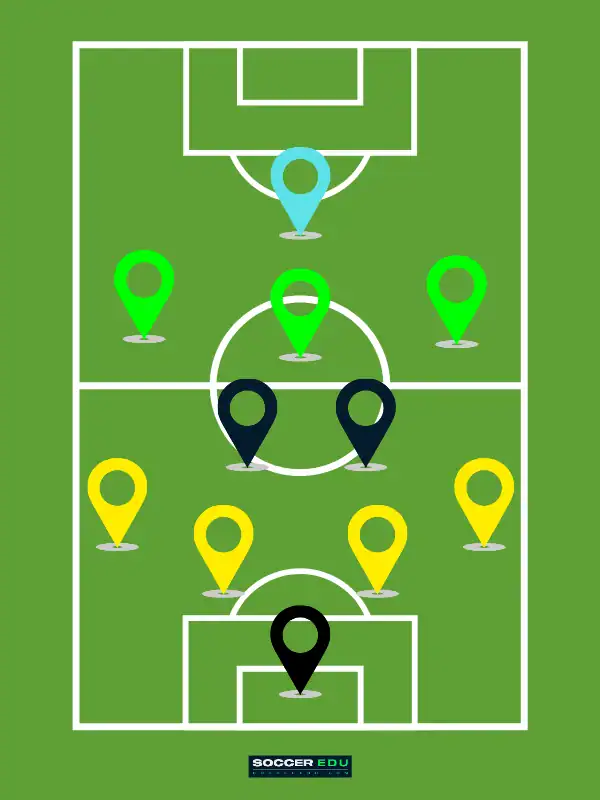The success of a soccer team largely depends on well-designed tactics. Among all the strategies used, the 4-2-3-1 stands out as a versatile and balanced system, favored by many top-level coaches.
In this article, we’ll dive deep into this tactic by explaining exactly what the 4-2-3-1 is, how it’s played, why it has grown in popularity and how it differs from other formations. You’ll discover all the essential aspects of this system and receive practical advice on how to successfully implement it with your team.
What is a 4-2-3-1 formation?
The 4-2-3-1 is a specific tactic that consists of four defenders, two defensive midfielders, three attacking midfielders and one striker.
Also called 4231, the “4” refers to the four defenders lined up in a row at the back, the “2” represents the two defensive midfielders placed in front of the defense, the “3” indicates the three attacking midfielders arranged behind the striker, and finally, the “1” refers to the lone striker who plays alone. It is a balanced formation because it combines solid defensive coverage with many creative options in attack.

How is the 4-2-3-1 formation played?
In a well-oiled tactic like the 4-2-3-1, every detail matters to achieve the best results on the field. The coach has a team made up of four defenders, two full-backs and two center-backs, whose mission is to protect the goal while preventing opposing attackers from breaking through. Working in perfect coordination, the two defensive midfielders, often called the “pivots”, play a crucial role in ensuring a smooth transition between defense and attack. Their objective is to win back possession and deliver accurate passes to the attacking players.
In midfield, a line of three attacking midfielders takes shape: one central player and two wingers. This central player, often referred to as the “number 10,” holds a key position in this tactic as the true playmaker. His role is to create scoring opportunities and coordinate the team’s offensive movements. On either side, the two wingers bring speed, tricky dribbling and accurate crosses to put pressure on the opposing defense.
Up front, the striker becomes the team’s finisher. His role is to score goals by taking advantage of the chances created by the attacking midfielders. By staying in the opponent’s penalty area, he puts constant pressure on the defense, thereby creating opportunities not only for himself but also for his teammates.
In this soccer tactic known as the 4-2-3-1, each player has a specific task to carry out. Every action, every pass, every movement is carefully orchestrated by the coach to maximize the team’s offensive and defensive potential.
Why play in a 4-2-3-1 formation?
Choosing the 4-2-3-1 formation can be highly beneficial for a team due to its many tactical advantages.
The 4-2-3-1 provides solid defensive coverage thanks to the presence of two defensive midfielders positioned just in front of the back line. They are able to quickly win back possession and launch counterattacks that put the opponent under pressure.
The three attacking midfielders offer a range of creative options going forward. The wingers bring speed and width to the game, stretching the opposing defense and creating space for attacking players. The central player, often the team’s key playmaker, has the ability to make a difference in the most decisive moments.
The lone striker benefits from constant support from the attacking midfielders, giving him numerous goal-scoring opportunities. This tactical setup puts pressure on the opposing defense, forcing their defenders to remain alert throughout the match.
Teams that have already played in a 4-2-3-1 formation
The 4-2-3-1 has been successfully used by many well-known coaches and soccer teams in the United States, especially in Major League Soccer (MLS). For several reasons, this system has been one of the most widely employed due to its balance between defensive solidity and offensive creativity.

Among the teams that have adopted this tactic are notably :
- Atlanta United used the 4-2-3-1 as their base formation before occasionally adapting to the other systems like the 5-3-2.
- Orlando City also deployed this formation during the MLS Cup, as shown by certain official match sheets.
- Joachim Löw’s Germany used it during the 2014 World Cup.
- Hansi Flick’s Bayern Munich (2019/2020 season) successfully applied it, with Alphonso Davies at left back and David Alaba as a center-back.
These teams illustrate how the 4-2-3-1 can be successfully used at the highest level, whether in domestic or international competitions.
Pros and cons of the soccer 4-2-3-1 formation
The 4-2-3-1 is a soccer tactic that provides the team with a balanced combination of solid defense and creative attacking options. However, like any tactic, it has both pros and cons that are important to consider in order to make the most of it:
Pros of the 4-2-3-1
- Defensive solidity: The presence of two defensive midfielders in front of the defense strengthens the team’s solidity in their own half. These pivot players are responsible for winning back the ball, intercepting opponent passes and breaking up attacks. Having two players specialized in ball recovery allows better control of the midfield and reduces space for opposing attackers.
- Midfield control: The 4-2-3-1 provides a strong presence in midfield thanks to its two defensive midfielders and the central attacking midfielder. This allows the team to better control the game in midfield, impose their rhythm and dictate the tempo of the match.
- Creative attacking options: The three attacking midfielders (one central player and two wingers) offer a variety of creative attacking options. The central player, often the team’s playmaker, can create goal-scoring opportunities and deliver key passes. The wingers bring speed, tricky dribbling and accurate crosses to put pressure on the opposing defense.
- Quick transition: Thanks to the two defensive midfielders who can quickly recover the ball, the 4-2-3-1 formation allows rapid transitions from defense to attack. This can surprise opposing teams by creating fast and dangerous counterattacking situations.
Cons of the 4-2-3-1
- Need for defensively capable attacking midfielders: For the 4-2-3-1 to work effectively, the attacking midfielders must be able to defend and support the defensive midfielders. This means they need to be physically resilient and tactically disciplined to help recover the ball.
- Isolation of the lone striker: Playing alone upfront, the striker can sometimes feel isolated and lack support. They must be able to hold onto the ball and involve their teammates in the play to avoid becoming ineffective against a well-organized defense.
- Vulnerability to opponent counterattacks: With only two defensive midfielders, the 4-2-3-1 can leave gaps in midfield, which quick opposing teams can exploit on counterattacks. Strong coordination and communication between the defensive midfielders and defenders are essential to minimize this vulnerability.
- Specific player requirements: For the 4-2-3-1 formation to function efficiently, players need specific skills suited to their roles. Defensive midfielders must be good at ball recovery and distribution, while attacking midfielders must be creative and capable of scoring goals. A lack of players suited to these key roles can weaken the team’s overall performance.
The importance of communication and coordination
Communication and coordination among players in the 4-2-3-1 formation play a crucial role. They are the key to achieving a well-organized defense, smooth offensive movements and mutual support in all phases of the game.
The 4-2-3-1 allows for great flexibility. Communication between the players and the coach enables adjustments to each player’s role based on the opponents and the team they’re facing. The pivots play a crucial part, as they must maintain constant communication with both the defenders and the attacking midfielders to allow for a smooth transition between the defense and attack.
To fully succeed with the 4-2-3-1, training and developing communication are crucial aspects to consider. This will enable the team to create genuine harmony on the field and face challenges with confidence and effectiveness.
Other popular tactics
Although the 4-2-3-1 is a tactic used by many teams, there are other formations worth exploring depending on the strengths and weaknesses of your team.
Among them are the 4-3-3, the 3-5-2, the 4-4-2, the 3-4-3 and many others. Each tactic has its own pros and cons and it is essential to choose the one that best fits the philosophy and playing style of your team.
The 4-2-3-1 is a versatile and balanced soccer tactic that offers both solid defensive coverage and creative attacking options. Its successful implementation depends on precise execution and a deep understanding of each player’s role. As a coach, it is crucial to consider your team’s strengths and weaknesses, as well as the specific demands of the game to select the best tactic.





